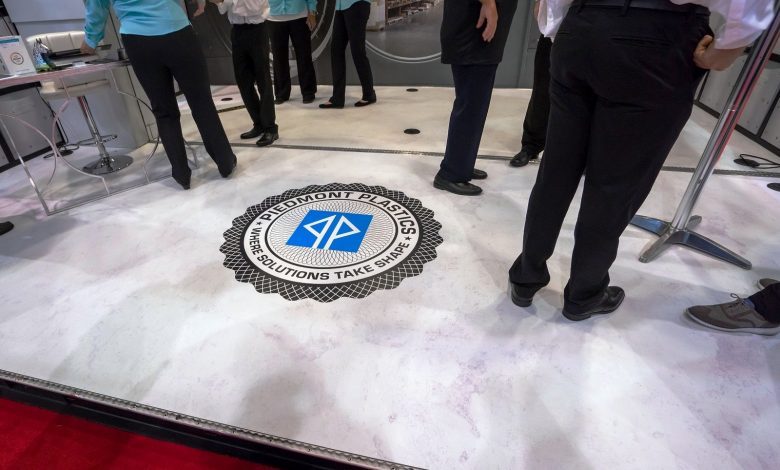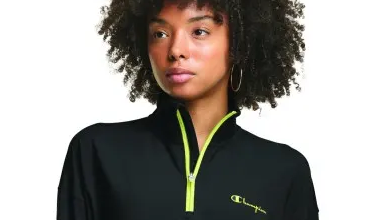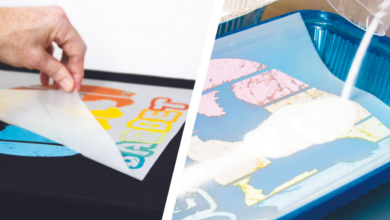The Lowdown on Floor Graphics
Applications require a little more work with floor graphics, but they are well worth the effort.
As customers walk through a store or down the sidewalk, they may not realize they’re scanning the floor-and if there are graphics, the bright, vivid images can catch their eye and bring in even more business.
Floor graphics direct customers through a business or office and are used for sales, event promotions, and advertising and branding, among endless other options. A tool for grabbing attention, floor graphics have been around for more than 20 years but recently have become trendy in all kinds of settings from grocery stores to airports.
“Fun trends that we have been seeing are graphics that play with the mind’s eye, like false three-dimensional designs. Floor graphics are also often used as wayfinding assets,” says Andrew Smith, application engineer for St. Paul, Minnesota-based 3M . “Using floor graphics to direct guests throughout businesses … can be very helpful.”
Creating compelling, attractive and useful floor graphics isn’t as simple as it sounds to ensure they retain their look and last more than a few days. Floor graphics don’t have a long lifespan, typically up to six months, depending on the manufacturer, as well as the life of the imprint, the slip-resistant properties and the adhesive bond to the surface. Retailers and businesses don’t require longevity, often wanting to change their messaging, and trade show organizers want to put up and quickly take down their shows.
But they want some longevity and to achieve a level of performance.
From Design to Installation
To meet that need, floor graphics require several key steps in the design, print, lamination and installation processes before they can be placed on an interior floor or outside on asphalt or concrete. The processes are dependent on the materials that are used and the wear and tear on the flooring.
“The creation process of attractive floor graphics relies on the designer,” says Paul Roba, OEM relationship manager for Mentor, Ohio-based graphics films manufacturer Avery Dennison. “Creating an eye-catching, quickly understood message is key, and it can be achieved using impactful colors and designs with few words.”
The designer should consider the audience in the design process since the audience will be standing five to six feet above the graphic, says Micah Causey, vice-president of business development for FloorSignage LLC, in Worthington, Ohio. Causey recommends avoiding small text or details and considering the location for decisions on the content and design.
“Graphics at entrances can reach every customer that enters the store to inform of new products or sales, while graphics placed intermittently as directional or wayfinding to a display or section of a store can creatively include additional information that educates the person viewing the graphics,” Causey says.
Causey suggests avoiding designs with sharp corners or points that can be problematic when removing the release liner or can complicate the installation process. Instead, he recommends incorporating contours on corners and points to allow the adhesive to have a better bond with the large surface areas.
Otherwise, the design process can be unlimited, since floor graphics just need to be printed, cut out on a plotter and applied to the floor surface, which might be sealed tile, cement, or an unsealed surface or carpeting, Roba says.
The proper graphic film for flooring, usually a white film backed with adhesive, needs to be used, as well as a protective laminate that provides stability and protects the graphic, Roba says. The graphic film and laminate-which comes in different types of gloss, matte, safety and anti-scratch-are selected based on exposure to foot traffic and outside conditions, such as rain, snow and sun, as well to meet any slip resistance standards to protect against potential hazards, he says.
“For example, a sidewalk graphic may be exposed to the elements, where moisture from precipitation could create a slip hazard,” says Jonathan Gerlach, marketing manager of Intermediate Films for 3M Commercial Solutions, recommending an anti-slip overlaminate, such as 3M Scotchcal Matte Overlaminate 3647, as a good option for safety and durability.
The Use of Laminates
The use of laminates, also called overlaminates, can increase the life of a graphic up to one year, but for sidewalks, the lifespan is up to three months, Gerlach says, adding that he recommends laminates that are UL-approved by Underwriters Laboratories for product safety testing and certification.
“A UL-approved floor overlaminate that is ideal for the environment will maximize the success of the graphic by minimizing slips, trips and falls,” Gerlach says.
Graphics used in interior smooth floor applications work best with laminates, such as 3M Scotchcal Luster Overlaminate 8509, to improve the appearance and longevity of the graphic, Gerlach says. Before installing the laminate, he recommends first testing out the floor waxes that will be used to clean and maintain the floor to ensure protection of the graphics.
Roba also recommends following the manufacturer’s instructions to outgas the graphic film, removing any extra gases after printing the design, before beginning the lamination process.
“Following a manufacturer’s processing, installation and maintenance instructions will result in optimally safe and effective floor graphics,” Roba says.
Printing, laminating and installing floor graphics typically follow a similar process to any other graphic vinyl film. Once the film is printed and laminated, it can be installed, preferably on a smooth-surface floor away from sharp corners to avoid lifting of the edges after application.
“When applying the graphic to floors with uneven surfaces, such as tile floors with deep grout lines, remember that bridged film may crack or rip, shortening the life of the graphic. Also, do not align the edges of a graphic on the grout lines, as this may cause premature lifting of the graphic,” Gerlach says.
For rough surfaces such as sidewalks, 3M recommends using films with a more aggressive adhesive, like 3M Scotchcal Graphic Film 3662, Smith says. The films can be installed using a stiff-bristled brush to work the material into the contours, keeping the film down and flat to prevent lifting and increasing the film’s expected life performance, he says.
FloorSignage LLC offers a substrate, AlumiGraphics Grip, that can conform to various textures without heat because the foil base material is pliable and has a special adhesive that makes it easy to apply and remove, Causey says.
“When vinyl-based films are applied to outdoor walkways, the graphics will typically require heat to conform to textured surfaces,” Causey says. “The floor graphic substrates made by FloorSignage LLC are designed with the end user in mind. … No matter what the planned posting period is, we always recommend applying test swatches of each material you are considering on the intended surface to compare and confirm compatibility and expected performance.”
With both smooth and rough surfaces, the areas for the installation should be clean of any dirt and free of loose tiles or flooring, Roba says.
Once the graphics are installed they should be inspected regularly, and any graphic with edges that are lifting should be removed, replaced or repaired, because they present a slip hazard, Roba says.
“Since you have no control (over) what can happen once floor graphics are installed either indoors or outdoors, only choose materials that have a combination of certifications for wet and dry environments, including UL 410, ANSI B101.3 and HB198,” Causey says. “Films and overlaminates that do not have these certifications should be avoided for safety precautions.”
A Non-Laminate Option
Infinity Media Co. in Countryside, Illinois, offers a different kind of floor graphic that does not require lamination.
“It’s just print, cut and place,” says Russell Nicoletti, president of Infinity Media Co. “Laminate gets torn up. … This is a better, quicker way to put out floor graphics that pop.”
Infinity Media Co. released FloorAppeal for indoor and outdoor floor graphics that do not need the lamination step, which may need to be redone if the laminate sticks or wrinkles.
FloorAppeal has a scratch-resistant coating, is made out of fabric polyester that is difficult to tear, contains anti-slip glass beads and has a high bright white point so that cleaning removes the dirt but not the ink,” Nicoletti says.
“It means the media itself is white,” Nicoletti says. “When they print on it, the colors pop very well.”
FloorAppeal can last six months to a year indoors and up to six months outdoors. It features a LOW-TAC version for smooth indoor surfaces, such as plastic laminates, wood, linoleum, tile and carpeting and HIGH-TAC for smooth outdoor surfaces like concrete, paving stone, some bricks and plush and shag carpeting. HIGH-TAC EX has extra strength for rough outdoor surfaces like aging concrete, asphalt and brick.
“Our material is so strong, it doesn’t tear,” Nicoletti says. “It’s very durable.”
Comparatively, laminated graphics can peel and tear and the corners can lift because of the glued adhesive, Nicoletti says.
FloorAppeal is simple to use, requiring fewer steps for installation than laminated graphics, Nicoletti says. The wax paper liner protecting the adhesive needs to be removed, and as the liner is slowly pulled off, the graphic needs to be lined up and smoothed, he says. The graphic is laid down by hand or with a roller or soft squeegee, he says.
“When you’re dealing with vinyl, if that stuff sticks together, you can’t pull it apart,” Nicoletti says. “With ours, if it sticks, you just pull it apart and it un-sticks. … When you go to take it up, it comes up in one piece.”
Graphics on Carpeting
Graphics on carpeting require special treatment to make sure the installation is successful.
Roba recommends using a permanent adhesive for carpet graphics to address the difficulty of film adhering to carpet. The permanent adhesive still can be removed once the graphic is no longer needed or is at the end of its life, he says.
“When placed on carpeting, the edges of floor graphics can more easily be caught or lifted than when applied to hard, rigid flooring,” Causey says. “Additionally, graphics on carpet can be punctured with sharp objects, including high heels.”
Causey recommends selecting a dimensionally stable material that lies flat and is puncture- and tear-resistant, such as FloorSignage’s new material, EZGrip Graphics, that can be used on a variety of indoor flooring types including carpeting.
Once the right materials are selected for carpeting, the graphics add color and decoration to an otherwise plain surface.
“Decoration on top of carpeting, it adds flair,” Nicoletti says. “When they see the graphic on there, it catches their eye.”












